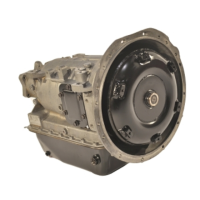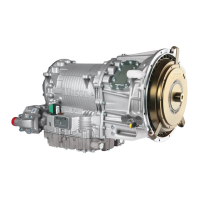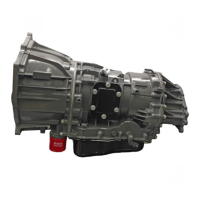Copyright © 1996 General Motors Corp. 3–1
3–1. SCOPE
(1) This section outlines the routine and pe-
riodical procedures required to maintain the transmis-
sion in good operating condition.
(2) For transmission removal and installation
guidelines, engine adaptation hardware specifications,
and road test checks, refer to the AT Mechanic’s Tips,
SA1321.
3–2. PERIODIC INSPECTION
AND CARE
a.
Clean and inspect the exterior of the transmis-
sion at regular intervals. The severity of service and
operating conditions will determine the frequency of
such inspections. Inspect the transmission for:
•
loose bolts (transmission and mounting
components)
•
transmission fluid leaks*
•
shift linkage freely positioned by transmis-
sion detent
•
full (and ease of) movement of mechanical
modulator linkage
•
vacuum or air line and modulator for leaks
•
damaged or loose hydraulic lines
•
worn or frayed electrical connections
•
driveline U-joints and slip fittings
•
speedometer cable and fittings
•
PTO linkage and driveline
b.
Check the transmission hydraulic level at the
intervals specified in the vehicle operator manual.
3–3. IMPORTANCE OF PROPER
TRANSMISSION FLUID LEVEL
a. Effects of Improper Fluid Level.
Because
the transmission fluid cools, lubricates, and transmits
hydraulic power, it is important that the proper fluid
level be maintained at all times. If the fluid level is too
low, the converter and clutches will not receive an ade-
quate supply of fluid. If the level is too high, the fluid
will aerate, the transmission will overheat, and fluid
may be expelled through the breather or dipstick tube.
b. Foaming and Aerating
(1) Transmission performance will be af-
fected when the fluid foams or aerates. The primary
cause of aeration is low fluid in the sump, too much
fluid in the sump, or a defective or missing sealring on
the intake tube.
(2) A low fluid level (denoted on the dip-
stick) will not completely envelop the fluid filter.
Therefore fluid and air are drawn in by the input pump
and directed to the clutches and converter, causing
converter cavitational noises and irregular shifting.
The aeration also changes the viscosity and color of
the fluid to a thin milky liquid.
(3) At normal fluid level, the fluid is slightly
below the planetary gear units. If the transmission is
overfilled, the planetary units will run in the fluid,
causing it to become aerated. Overheating and irregu-
lar shift patterns can occur when the fluid is aerated.
(4) A defective sealring 20, 37, or 45 (Fold-
out 12,B) on the filter intake tube will cause the input
pump to draw air and fluid from the sump, causing the
fluid to become aerated.
3–4. DIPSTICK MARKINGS
Three dipstick variations are available for use with the
AT 500 and 1500 Series transmissions. The dipstick
will have markings similar to those seen in Figure 3–1,
3–2, or 3–3. Variations in fill tube placement and dip-
stick orientation may change these dimensions
slightly.
Section 3 – PREVENTIVE MAINTENANCE
* Transmission fluid leaks require immediate attention.

